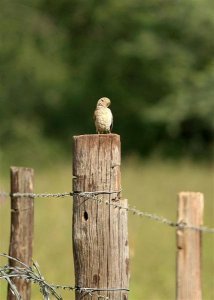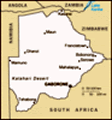Advertisement
Published: April 12th 2008

 A not so sociable Sociable Weaver Bird
A not so sociable Sociable Weaver Bird
Having stopped by the side of the road, we noticed large nests all around. These little birds build the largest structures known amongst the bird community and you can see them adorning many of the trees along the road between Windhoek and Ghanzi.Dawn broke - but was fixed in time for my alarm to go off at 06h45. I’d slept well, my sleep punctuated by the constant singing of the grasshoppers. After a hot shower, I donned the same set of clothes worn yesterday and headed to breakfast. Never having been to Namibia before, I wasn’t sure what to expect and was rather surprised by the sumptuous feast laid on. Unfortunately, after several days of eating a very odd times, I really wasn’t hungry and simply had two pots of coffee, a bread roll and two fried eggs and some bacon.
Alfred was already waiting for me at the table and commented on the shirt I was wearing; well, it was his! My two fellow travellers arrived, completed their breakfast and we all headed back to our rooms to pack; I returned interfrastically having wrapped my few toiletries in a carrier bag.
Heading off to the bar, I purchased a large bottle of fresh water and went to check at reception as to the whereabouts of my luggage. Being Sunday, they were not hopeful, but did put a call through to the airport - to no avail. Seems as though I
really will be doing a two week safari with just the clothes on my back!
Windhoek to Botswana
With military precision, 07h30 arrived and we deposited our bags in the trailer. After some discussion as to seating arrangements, I opted to allow Brian and Jill to sit in the second row whilst I occupied the third row, next to the cool box. This would allow Brian to take photographs from the left of the vehicle leaving Jill to cover the vista towards the right.
Heading out on the B6, we initially followed signs to the airport, built on the only flat area for some considerable distance. Rather ironic considering that Windhoek is considered to be on the Central Plateau!
Still, we set our sights on Kapps and headed across the start of the Kalahari. I’d been expecting sand and was somewhat surprised to discover that the Kalahari was covered in bush and scrub. Kalahari means “The Great Thirst” and is a massive sandy area covering some 70%!o(MISSING)f Botswana and reaching into Namibia, South Africa, Angola and Zambia; an area of over 350000 square miles.
It wasn’t long before the first of the wildlife was spotted.
As it turned out, this was the only sighting of Oryx I was to make and a photograph was completely out of the question.
After 100km in the warm sun, driving on unprecidently straight roads with almost no traffic, we pulled into a lay-by for a quick break. Hopping down, I was immediately taken in by the immense silence (apart from the singing grasshoppers). It was all so oppressive.
On closer examination, however, I realised that there was an abundance of wildlife. All around me, the trees were full of tatty Sociable Weaver Bird nests. With one particularly unsocial specimen preening itself on a fence post a few feet away. There were African Monarch butterflies everywhere and a particularly impressive example of an impala. I say impala, but what I mean is that one expects to see bones in a desert and I wasn’t disappointed!
Amongst the grass, I spotted a rather large beetle, although I have no idea of its name. I later found out that it had cannibalistic tendencies, which made for some rather spectacular photos.
Break over, we rejoined the straight, deserted desert road and headed through Witvlei into Gobabis. Alfred decided to

 King Cricket
King Cricket
Not at all certain as to what this is. It may be a beetle and may even be an insect. I can tell you that they were everywhere. Every time you moved past a bush, there would be a rustle and maybe 20 or 30 of these little monsters would be moving into cover.
[Post Publication Note: Identified by Don as a King Cricket]fill up with fuel as one of his tanks was becoming empty and Jill had spotted a shop which appeared to sell clothes. Leaving Alfred to do his bit, I crossed the road and entered the delights of a central African clothes emporium to find myself somewhat spoiled for choice. In the end, I came away with three sets of “sleeping shorts”, 3 pairs of socks and 3 shirts - all for £20 - not bad. More importantly, I’d also acquired a second carrier bag!
Continuing towards the border, I became more receptive to the animals we were passing and was delighted to see kudu, baboons and more sociable weaver birds.
Arriving at the border crossing, we popped into a petrol station and spent all the Namibian loose change on biscuits. Notes were useful in Botswana, but loose change would just be a nuisance. Returning to the vehicle, I notice some more of the beetles that I’d seen in earlier in the day. This time, however, two of them were attacking a third, eager for a meal. Rather gruesome but a great photo!
Walking into the border post, we completed the paperwork and a very nice young

 A King Cricket Match?
A King Cricket Match?
Whilst our guide was getting fuel, we walked across the sand to the local shop. There in the middle were these two crickets busily beating up a third and attempting to chomp their way through its carapace.lady stamped my passport to confirm that I had left Namibia. The only snag was now that I hadn’t yet entered Botswana, so I guess I was a genuine itinerant.
Driving the 100 yards or so to the second border, we completed a similar set of paperwork and, after some formal exchanges of greetings with the immigration staff, the passport was stamped and I was formally welcomed into Botswana.
Ghanzi
Driving through the border post at Mamuno, Alfred informed us that Foot and Mouth was rife in Botswana and we would have to cross several zones separated by checkpoints. As the temperature soared, we headed across the Kalahari, through Kalkfontein, arriving in Ghanzi for lunch - at 14h30!
Despite the appearance of a dusty, remote outpost, Ghanzi is the administrative capital. One therefore, would expect a plethora of eating and drinking establishments. Instead, we pulled into the only real eating place, the Kalahari Arms Hotel, and made a bee-line for the open-air restaurant at the back. I use the word “restaurant” in its loosest sense, but it was very pleasant, clean, picturesque and relatively insect free. After ordering a steak sandwich and a St. Louis, I soon
came to realise that chips were a staple in these parts. However, the meal was very tasty and certainly filled a hole.
Returning to the truck, we continued along the B6 to the village of D’Kar. Pulling off the road, we headed across the bush for some 10 miles until we arrived at the Dqãe Qare Game Farm, the only San owned game farm in Botswana. The farm comprises some 20,000 acres and is reputedly stocked with animals such as springbok, gemsbok, red hartebeest, zebra, giraffe, ostrich, jackal, caracal and many species of bird, although, all we actually saw were kudu, warthog, cape buffalo, ostrich and zebra - not at all bad.
After being allocated our rooms, Brian and I headed into the bush to take some photographs and thereafter, retired to the bar. Forget the stereotypical smog-filled, wood-panelled enclosed space filled with 50-something guys with beer-bellies, this was an open air affair, next to the watering hole and frequented by two Austrian hippies! Both had no plans on arriving and no plans on staying, having travelled on a local bus from the capital, Gaborone. They were sat, in true bare-footed hippie fashion, staring at the sunset.

 Impala - we'd been spotted
Impala - we'd been spotted
No sooner had we pulled off the main road and onto a sand track, we began to see animals everywhere. Keeping sight of them for photographic purposes was tricky, but this little lady was happy to watch and see what we did. We just took a photo!After a meal of steak and potatoes, we gathered around the campfire where the local Ncoakhoe people, the particular tribe of San at the farm, meaning “the red people” in their own language, Naro, performed a series of dances. These have evolved over 10’s of thousands of years and depicted the animals and how they all live together in the apparently hostile environment. The last dance of the evening was entitled “Hunting the Oryx” with one of the dancers taking the role of an Oryx and being jumped on by the rest of the troop - clearly this was their favourite dance and we certainly enjoyed it too.
Once the frivolity was over, we moved away from the campfire and noticed how clear the sky was. The Milky Way was phenomenal by its presence, the occasional shooting star providing some movement to the background of stars. Coming from the Northern Hemisphere, it was a real delight to be able to see the Magellanic Clouds and the Coal Sack - an area of sky hidden by a dark interstellar cloud.
Talking about dark, interstellar clouds, the generator was turned off at 22h00 and the site was plunged into darkness.

 Tortoise
Tortoise
This little chap had certainly been on the Red Bull; I'm not surprised the hare lost the race. Notice the camouflage ...Retiring to our respective rooms, I lit a candle or two, washed and fell into a dreamless sleep.
Advertisement
Tot: 0.079s; Tpl: 0.013s; cc: 12; qc: 28; dbt: 0.0356s; 1; m:domysql w:travelblog (10.17.0.13); sld: 1;
; mem: 1.2mb















don
non-member comment
Beetles Identified
The "beetles" in your blog are actually King Crickets, and are very numerous after a good rainy season.